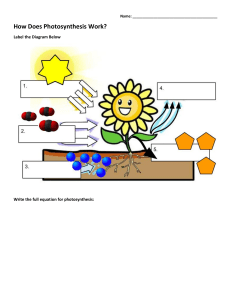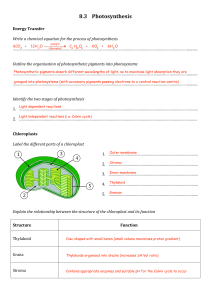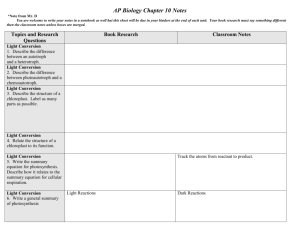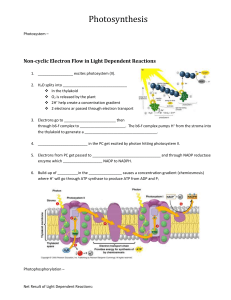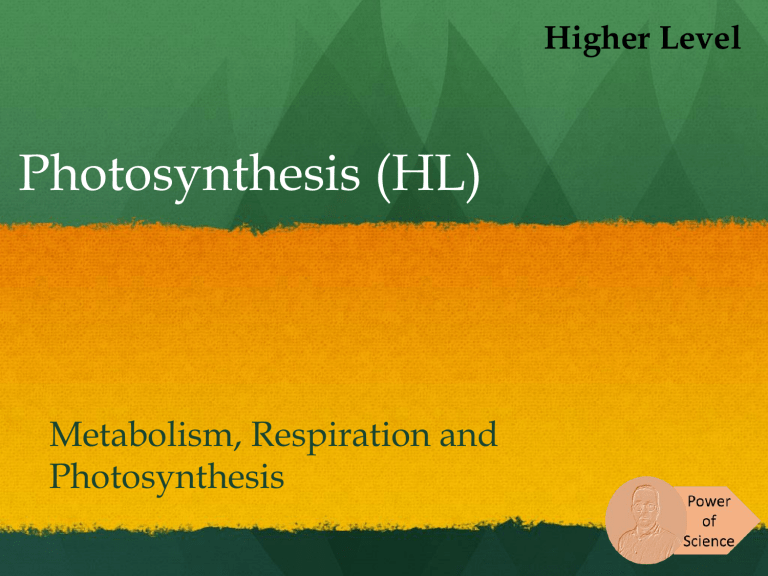
Higher Level Photosynthesis (HL) Metabolism, Respiration and Photosynthesis Essential Idea Light energy is converted into chemical energy. Nature of Science Developments in scientific research follow improvements in apparatus—sources of 14 C and autoradiography enabled Calvin to elucidate the pathways of carbon fixation. IB Understandings ● Light-dependent reactions take place in the intermembrane space of the thylakoids. ● Light-independent reactions take place in the stroma. ● Reduced NADP and ATP are produced in the light-dependent reactions. ● Absorption of light by photosystems generates excited electrons. IB Understandings ● Photolysis of water generates electrons for use in the light-dependent reactions. ● Transfer of excited electrons occurs between carriers in thylakoid membranes. ● Excited electrons from Photosystem II are used to generate a proton gradient. IB Understandings ● ATP synthase in thylakoids generates ATP using the proton gradient. ● Excited electrons from Photosystem I are used to reduce NADP. ● In the light-independent reactions a carboxylase catalyzes the carboxylation of ribulose bisphosphate. IB Understandings ● Glycerate 3-phosphate is reduced to triose phosphate using reduced NADP and ATP. ● Triose phosphate is used to regenerate RuBP and produce carbohydrates. ● Ribulose bisphosphate is reformed using ATP. ● The structure of the chloroplast is adapted to its function in photosynthesis. IB Application and Skills ● Application: Calvin’s experiment to elucidate the carboxylation of RuBP. ● Skill: Annotation of a diagram to indicate the adaptations of a chloroplast to its function. Photosynthesis Overview Photosynthesis Photosynthesis Photosynthesis is introduced in Core Topic 8.3 Photosynthesis. 1. Define photosynthesis. 2. State the name of the pigment that absorbs light for photosynthesis. 3. State the colors (wavelengths) of light that are best absorbed and reflected by the main photosynthetic pigment. Diagram of a Chloroplast Outer Membrane Thylakoid Space Stroma Inner Membrane Thylakoid Membrane Ribosome Granum Lipid Droplet Starch Grain The following slides outline the functions of structures found in chloroplasts. The functions become clearer as we look at the stages of photosynthesis. Chloroplast Structure The function of chloroplasts is photosynthesis, which uses light energy to produce organic compounds. Chloroplasts contain the following key structures: Stroma - The stroma contains 70S ribosomes, DNA nucleoid region, and all of the enzymes required for the Calvin Cycle (light dependent reactions). Nucleoid region - contains a single circular chromosome, which includes genes for the synthesis of enzymes required for photosynthesis Chloroplast Structure Ribosomes - synthesize proteins for the chloroplasts including the enzymes required for photosynthesis. Thylakoid membranes - are organised into stacks of grana. The thylakoid membrane contains: photosystems (containing chlorophyll), electron transport chains and ATP synthase. Thylakoid lumen / space - allows for the concentration of protons (H+) to accumulate quickly. Stages of Photosynthesis Stages of Photosynthesis Light Dependent Reactions ● Non-cyclic photophosphorylation – produces ATP and NADPH (Reduced NADP) ● Cyclic photophosphorylation – produces ATP The Calvin Cycle (Light Independent Reactions) ● Uses ATP and NADPH from the light dependent reaction, and carbon dioxide to produce glucose and other organic compounds. Light Dependent Reactions In the light dependent reactions, sunlight is absorbed by photosystems (containing chlorophyll) to release high energy electrons. ● The high energy electrons provide energy that is used to produce ATP (using an electron transport chain found in the thylakoid membrane and chemiosmosis). ● The electron carrier NADP+ is reduced to NADPH when it gains electrons from chlorophyll. Light Dependent Reactions There are two different light dependent pathways: ● Non-cyclic photophosphorylation - which produces ATP and NADPH. ● Cyclic photophosphorylation - which produces ATP. The ATP and NADPH are used in the Calvin cycle to produce organic compounds. Noncyclic Photophosphorylation Explain Non-Cyclic Photophosphorylation The video on the previous slide describes non-cyclic photophosphorylation. Refer to chemiosmosis and wavelengths of light absorbed by chlorophyll in your answer. Chlorophyll Chlorophyll in photosystems absorbs light energy to release electrons to electron transport chains. ● Chlorophyll absorbs mainly red and blue light. ● Chlorophyll reflects green light. ● Accessory pigments (carotene and xanthophyll) can absorb some light of different wavelengths and pass the energy to chlorophyll. Events of Non-cyclic Photophosphorylation Photoactivation of Photosystem II (PSII): Light shines on PS II (within the thylakoid membrane). Electrons absorb light energy, and escape from chlorophyll. The electrons move along an electron transport chain within the thylakoid membrane. PS II has lost electrons and is positively charged. Photolysis of water: The positively charged PS II removes electrons from water to replace electrons lost by photoactivation. Water is split into H+ and O2. Oxygen gas is released as a waste product. Events of Non-cyclic Photophosphorylation Electron transport chain: The electrons released from PS II travel along an electron transport chain within the thylakoid membrane. The energy from the electrons actively pumps protons (H+) from the stroma into the thylakoid space. Chemiosmosis: A high concentration of H+ is present in the thylakoid space. The H+ returns to the stroma through ATP synthase. The moving H+ provide energy for ATP synthase to catalyze the conversion of ADP and phosphate to ATP. Events of Non-cyclic Photophosphorylation Photoactivation of Photosystem II (PSII): Electrons arrive at PS I from the electron transport chain. Light shines on PS I, exciting electrons which escape from chlorophyll. Reduction of NADP+: The electrons lost from PS I are accepted by the electron carrier NADP+. H+ (from photolysis of water), electrons and NADP+ form reduced NADPH. Non –Cyclic Photophosphorylation Notes ● The ATP and NADPH produced during non-cyclic photophosphorylation are used in the Calvin cycle. ● The process involves many oxidation (loss of electrons) and reduction (gain of electrons) reactions. ● The process is referred to as non-cyclic photophosphorylation because the electrons lost from PS II do not return to PS II. They are replaced by electrons from water. Cyclic Photophosphorylation Outline Cyclic Photophosphorylation The video on the previous slide describes cyclic photophosphorylation in bacteria. This process also happens in plants when there is a low concentration of NAD+. Events of Cyclic Photophosphorylation Photoactivation of PS I: Light shines on PS I, exciting electrons. The electrons gain enough energy to escape from chlorophyll. Electron transport chain: The electrons released from PS I travel along an electron transport chain within the thylakoid membrane. The energy from the moving electrons actively pumps protons (H+) from the stroma into the thylakoid space. The electrons return to PS1. Events of Cyclic Photophosphorylation Chemiosmosis: A high concentration of protons (H+) is present in the thylakoid space. The protons return to the stroma through ATP synthase. The moving H+ provide enough energy for ATP synthase to catalyze the conversion of ADP and phosphate to ATP. 1. Explain why this is cyclic photophosphorylation. 2. Distinguish between cyclic and noncyclic photophosphorylation. The Calvin Cycle IB Naming of Chemicals in the Calvin Cycle There are different names for the chemicals which feature in the Calvin cycle. You need to know the names that the IB prefers: ● RuBP breaks down to an unstable 6-carbon compound which breaks down to glycerate 3phosphate. ● Glycerate 3-phosphate is reduced to triose phosphate. Describe the Calvin Cycle The Calvin Cycle The Calvin cycle is also known as the light independent reaction of photosynthesis, as it does not need light. ● The Calvin cycle occurs in the stroma where the enzymes required for the cycle are synthesized by the chloroplasts’ ribosomes. ● The Calvin cycle uses the products of the light dependent reactions (ATP & NADPH), carbon dioxide and RuBP (Ribulose Bisphosphate) to generate glucose and other organic compounds. The Calvin Cycle Carboxylation of Ribulose bisphosphate (RuBP): RuBP reacts with carbon dioxide to produce an unstable 6 carbon compound. The enzyme Rubisco (ribulose bisphosphate carboxylase) catalyzes the reaction. Production of glycerate 3-phosphate: The unstable 6 carbon compound breaks down to two glycerate 3-phosphate molecules. The Calvin Cycle Reduction of glycerate 3-phosphate: Glycerate 3phosphate is reduced to triose phosphate by electrons and H+ from NADPH. ATP provides the energy for this reaction to happen. Production of glucose: Some triose phosphate is converted to glucose. Regeneration of RuBP: Most triose phosphate is converted back to RuBP. Energy from ATP (from light dependent reactions) is required for this reaction. Glucose The glucose produced by the Calvin cycle can be: ● Respired ● Converted to vitamins ● Converted to other carbohydrates including starch and cellulose ● Converted to amino acids ● Converted to lipids ● Converted to nucleic acids Adaptations of Chloroplasts ● The stroma contains DNA which includes the genes for making the proteins required for photosynthesis. ● Ribosomes synthesize all of the enzymes required for photosynthesis (including Rubisco). ● The thylakoid membrane provides a large surface area for light absorption and electron transport chains. ● The small space within the thylakoid membranes allows for the rapid build up of H+. Calvin’s Lollipop Apparatus Calvin’s Lollipop Apparatus Developments in scientific research follow improvements in apparatus—sources of radioactive C-14 and autoradiography enabled Calvin to elucidate (to work out) the pathways of carbon fixation. Read the linked article. Describe the method that Calvin and his team used to elucidate the sequence of chemicals present in the Calvin Cycle. Calvin’s Lollipop Experiment Chlorella algae were added to the lollipop apparatus. The algae were provided with bright light and a radioactive source of Carbon dioxide. Samples of the algae were dropped into boiling alcohol at five second intervals. This kills the cells and stops photosynthesis. The dead algae were analysed using two-way chromatography. The sequence of chemicals in the Calvin cycle was determined by the order that radioactive molecules appeared on the chromatograms. Review Essential Idea Light energy is converted into chemical energy. Nature of Science Developments in scientific research follow improvements in apparatus—sources of 14 C and autoradiography enabled Calvin to elucidate the pathways of carbon fixation. IB Understandings ● Light-dependent reactions take place in the intermembrane space of the thylakoids. ● Light-independent reactions take place in the stroma. ● Reduced NADP and ATP are produced in the light-dependent reactions. ● Absorption of light by photosystems generates excited electrons. IB Understandings ● Photolysis of water generates electrons for use in the light-dependent reactions. ● Transfer of excited electrons occurs between carriers in thylakoid membranes. ● Excited electrons from Photosystem II are used to generate a proton gradient. IB Understandings ● ATP synthase in thylakoids generates ATP using the proton gradient. ● Excited electrons from Photosystem I are used to reduce NADP. ● In the light-independent reactions a carboxylase catalyzes the carboxylation of ribulose bisphosphate. IB Understandings ● Glycerate 3-phosphate is reduced to triose phosphate using reduced NADP and ATP. ● Triose phosphate is used to regenerate RuBP and produce carbohydrates. ● Ribulose bisphosphate is reformed using ATP. ● The structure of the chloroplast is adapted to its function in photosynthesis. IB Application and Skills ● Application: Calvin’s experiment to elucidate the carboxylation of RuBP. ● Skill: Annotation of a diagram to indicate the adaptations of a chloroplast to its function. See My Other Resources Please visit my TpT store for more resources IBDP Biology SL Core + Option D Bundle IB Biology Practical Work Topic 1 BUNDLE: Cell Biology All IB Biology Required Practicals 1- 7 Bundle Topic 2 BUNDLE: Molecular Biology IB Biology Internal Assessment Bundle Topic 3 BUNDLE: Genetics Topic 4 BUNDLE: Ecology Topic 5 BUNDLE: Evolution and Biodiversity Topic 6 BUNDLE Human Physiology Middle School/High School Brain Breaks With built-in randomizer spinner – easy/no prep Brain Breaks/Energizers/Ice-Breakers Topic 7 BUNDLE: Nucleic Acids Option D SL BUNDLE Human Physiology Option D HL BUNDLE Human Physiology IB MYP Science Resources Coming Soon For more quality science and biology resources, (including IB MYP and IBDP) visit my TpT store: teacherspayteachers.com/Store/Power-Of-Science Power Of Science Thank you! Thank you for purchasing this product - I hope you find it useful in your classroom. Please only use it in your own classroom with your own students. I retain the copyright and reserved all rights to this product. Thank you for being an Academic Honesty role model for your students and colleagues. You may: Use free or purchased resources for your own classroom use. Share the link to my TpT store so that your colleagues can access my products You may not: Claim this work as your own, or remove my name/copyright notice or watermarks. Sell or give away the files, or combine them with others to sell/give away. Make copies of items, other than for your own classroom use. This is a violation of the TOU/law. For more quality science and biology resources, (including IB MYP and IBDP) visit my TpT store: teacherspayteachers.com/Store/Power-Of-Science Power Of Science

